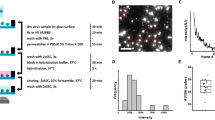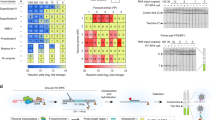Abstract
Specific hybridization primers for the PCR assay were developed to detect the presence of the ecotropic, xenotropic, and mink cell focus-forming classes of murine leukemia viruses (MuLVs) in samples derived from cultured cells and cell-free supernatants. The primers, which were tested against reference viruses from all three classes and two subclasses and accurately identified each class present, were used to characterize the endogenous expression of MuLV-related sequences in a number of murine and mink cell lines. Two murine/murine hybridomas were shown to contain expressed retroviral sequences from all three classes. The murine cell lines SC-1, Balb/c 3T3, and NIH 3T3, were found to constitutively express sequences from many of the MuLV classes. These MuLV-related sequences were not expressed in the Mus dunni or mink lung cell lines. When these primers were used in a quantitative PCR assay to determine the retroviral content of hybridoma supernatants, the values were less variable than those obtained by transmission electron microscopy (TEM). This assay can be adapted to detect and quantitate any viral contaminant in cell culture supernatants, ascites fluids, process validation samples, and final products.
This is a preview of subscription content, access via your institution
Access options
Subscribe to this journal
Receive 12 print issues and online access
$209.00 per year
only $17.42 per issue
Buy this article
- Purchase on Springer Link
- Instant access to full article PDF
Prices may be subject to local taxes which are calculated during checkout
Similar content being viewed by others
References
Bartal, A.H., Feit, C., Erlandson, R.A. and Hirshaut, Y. 1986. Detection of retroviral particles in hybridomas secreting monoclonal antibodies. Med. Microbiol. Immunol. 174: 325–332.
Machala, O., Mach, O., Bubenik, J. and Hasek, M. 1985. The presence of retroviral particles in hybridoma cell lines. Folia biologica (Praha) 32: 178–182.
Rozman, C., Vilella, R. and Vives, J. 1982. Viral particles in hybridoma clones secreting monoclonal antibodies. Lancet 2: 445–446.
Weiss, R.A. 1982. Retroviruses produced by hybridomas. N. Engl. J. Med. 307: 1–587.
Weiss, R.A. 1982. Hybridomas produce viruses as well as antibodies. Immunology Today 3: 292–294.
Guidelines on the production and quality control of monoclonal antibodies of murine origin intended for use in man. 1986. Tibtech 6: 5–8.
Joner, E. and Chrisitansen, G.D. 1988. Hybridoma technology products: required virus testing. BioPharm. 1: 50–55.
Lubiniecki, A.S. 1987. Safety considerations involving recombinant mammalian cell products. Genetic Engineering News 7: 16.
Points to consider in the manufacture and testing of monoclonal antibody products for human use 1987. Office of Biologies Research and Review, the Center for Drugs and Biologies, Food and Drug Administration, 8800 Rockville Pike, Bethesda, MD 20892.
Prince, D.L. and Prince, R.N. 1988. Quality assurance of monoclonal products: virologic and molecular biologic considerations. J. Industrial. Microbiol. 3: 157–165.
Coffin, J.M. 1982. Endogenous retroviruses, p. 1109–1203. In: Molecular Biology of Tumor Viruses. Part III: RNA tumor viruses, Vol. 1, 2nd ed. R. Weiss, N. Teich, H.E Varmus, and J.M. Coffin (Eds.), Cold Spring Harbor Laboratory, Cold Spring Harbor, N.Y.
Stoye, J.P. and Coffin, J.M. 1987. The four classes of endogenous murine leukemia virus: Structural relationships and potential for recombination. J. Virol. 65: 2659–2669.
Stoye, J.P. and Coffin, J.M. 1988. Polymorphism of murine endogenous proviruses revealed by using virus class-specific oligonucleotide probes. J. Virol. 62: 168–175.
Aronoff, R. and Linial, M. 1991. Specificity of retroviral RNA packaging. J. Virol. 65: 71–80.
Hartley, J.W., Wolford, N.W., Old, L.J. and Rowe, W.P. 1977. A new class of murine leukemia virus associated with development of spontaneous lymphomas. Proc. Natl. Acad, Sci. U.S.A. 74: 789–792.
Massey, A.C., Coppola, M.A. and Thomas, C.Y. 1990. Origin of pathogenic determinants of recombinant murine leukemia viruses: analysis of BXV-1-related xenotropic viruses from CWD mice. J. Virol. 64: 5491–5499.
Stoye, J.P., Moroni, C. and Coffin, J.M. 1991. Virological events leading to spontaneous AKR thymomas. J. Virol. 65: 1273–1285.
Li, J.-P. and Baltimore, D. 1991. Mechanism of leukemogenesis induced by mink cell focus-forming murine leukemia viruses. J. Virol. 65: 2408–2414.
Ishimoto, A., Hartley, J.W. and Rowe, W.P. 1977. Detection and quantitation of phenorypically mixed viruses: mixing of ecotropic and xenotropic murine leukemia viruses. Virology 81: 263–269.
Hass, M. and Patch, V. 1980. Genomic masking and rescue of dual-tropic murine leukemia viruses: role of pseudotype virions in viral lymphomagenesis. J. Virol. 35: 583–591.
Levy, J.A. 1977. Murine xenotropic type C viruses. II. Phenotypic mixing with mouse and rat ecotropic type C viruses. Virology 77: 797–810.
Stoye, J.P. and Moroni, C.H. 1984. Phenotypic mixing of retroviruses in mitogen stimulated lymphocytes: analysis of xenotropic and defective endogenous mouse viruses. 65: 317–326.
Losikoff, A.M., Poiley, J.A., Rainieri, R., Nelson, R.E. and Hilllesund, T. 1992. Industrial experience with the detection of retrovinises. Develop. Biol. Standard 76: 187–200.
Monroe, J.H. and Brandt, P.M. 1970. Rapid semiquantitative method for screening large numbers of virus samples by negative staining electron microscopy. Appl. Microbiol. 20: 259–262.
Lander, M.R. and Chattopadhyay, S.K. 1984. A Mus dunni cell line that lacks sequences closely related to endogenous murine leukemia viruses and can be infected by ecotropic, amphotropic, xenotropic, and mink cell focus-forming viruses. J. Virol. 52: 695–698.
O'Neill, R.R., Khan, A.S., Hoggan, M.D., Hartley, J.W., Martin, M.A. and Repaske, R. 1986. Specific hybridization probes demonstrate fewer xenotropic than mink cell focus-forming murine leukemia virus env-related sequences in DNAs from inbred laboratory mice. J. Virol. 58: 359–366.
Chan, H.W., Bryan, T., Moore, J.L., Staal, S.P., Rowe, W.P. and Martin, M.A. 1980. Identification of ecotropic proviral sequences in inbred mouse strains with a cloned subgenomic DNA fragment. Proc. Natl. Acad. Sci. USA. 10: 5779–5783.
Dickover, R.E., Donovan, R.M., Goldstein, E., Dandekar, S., Bush, C.E. and Carlson, J.R. R. 1990. Quantitation of human immunodeficiency virus DNA by using the polymerase chain reaction. J. Clin. Microbiol. 28: 2130–2133.
Peebles, R.T. 1975. An in vitro focus-induction assay for xenotropic leukemia virus, feline leukemia virus C, and the feline-primate viruses RD-114/CCC/M7. Virology 67: 288–291.
Rowe, W.P., Pugh, W.E. and Hartley, J.W. 1970. Plaque assay techniques for murine leukemia viruses. Virology 42: 1136–1139.
Hartley, J.W., Worford, N.K., Old, L.J. and Rowe, W.P. 1977. A new class of murine leukemia virus associated with development of spontaneous lymphomas. Proc. Natl. Acad. Sci. USA 74: 789–792.
Castillo, F.J., Mullen, L.J., Thrift, J.C. and Grant, B.C. 1992. Perfusion cultures of hybridoma cells for monoclonal antibody production. Ann. N. Y. Acad. Sci. 665: 72–80.
Heir, W. 1984. Nucleotide sequence of AKV murine leukemia virus. J. Virol. 49: 471–478.
Wang, A.M., Doyle, M.V. and Mark, D.F. 1989. Quantitation of mRNA by the polymerase chain reaction. Proc. Natl. Acad. Sci. USA. 86: 9717–9721.
Author information
Authors and Affiliations
Rights and permissions
About this article
Cite this article
Irving, J., Chang, L. & Castillo, F. A Reverse Transcriptase-Polymerase Chain Reaction Assay for the Detection and Quantitation of Murine Retroviruses. Nat Biotechnol 11, 1042–1046 (1993). https://doi.org/10.1038/nbt0993-1042
Received:
Accepted:
Issue Date:
DOI: https://doi.org/10.1038/nbt0993-1042



